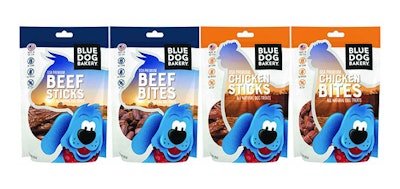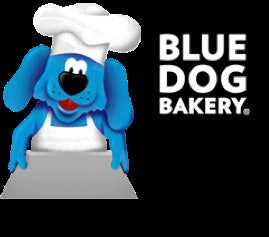
Blue Dog Bakery’s story began in 1998, when Founder Margot Kenly was still working in the human food industry. She primarily worked in the cookies and crackers business, supplying customers like Costco in the Northwest US. Through her job, she gained experience and contacts with bakeries, learning a lot about making cookies and crackers in the process.
The experience served Kenly well when a friend came to her about creating a natural dog treats business, and continued to serve her when they were developing their introductory treat — focusing on a solid, short ingredient deck, a high-quality final product and perfecting the necessary baking process. When the friend decided to go in a different direction, Kenly suddenly found herself with what she believed to be a premium-quality dog treat that she wanted to get out in the world. Her old Costco contacts were excited to try something new, and Blue Dog Bakery was born, quite unconventionally, on the shelves of a grocery/mass store chain.
From a unique start to today’s successes in grocery/mass
“We had some success long before the trend of natural pet foods and dog treats was where it has gotten to today,” says Eric Koppelman, chief revenue officer at Blue Dog Bakery. “And we think we have a great brand: a great superpremium-quality product with a short, simple-to-understand ingredient deck (their baked treats, for example, have whole wheat flour, wheat flour, black strap molasses, nonfat milk, eggs, baking soda, natural flavors, mixed tocopherols) that pet parents can read and recognize and feel good about feeding to their dog.”

Blue Dog Bakery Chief Revenue Officer Eric Koppelman, here with his seven-year-old rescued Brittany Spaniel mix Bruno and his 12-week-old Boston Terrier mix Bisou, believes Blue Dog Bakery has a bright future in the grocery/mass space, particularly as channel lines begin to blur and competition increases. | photo by Brian S. Pasko, Brian Pasko Photography LLC
That success has continued to grow, as Blue Dog maintains its shelf space in the grocery/mass markets while taking full advantage of its premium position in other areas of retail.
“We’re in a really nice position in the marketplace,” says Koppelman. “There’s been a blending of the channels in the last nine months in particular, but prior to that there was a very clear definition between pet specialty and grocery mass. We’re a pet specialty-quality brand that’s available in PetSmart and national retailers like that, but also widely available in grocery and mass. We provide a super high-quality product that is about a 10 to 15 percent premium to Milk-Bone, compared to what you’d typically find in your pet specialty store, which could be two to three times the price of Milk-Bone. I think it’s a very approachable, available product for a pet parent to find a high-quality treat for their dog.”
Taking advantage of a premium position in a grocery space
Having long established itself as a premium product on grocery store shelves, Blue Dog continues to keep an eye on the customer to ensure continued success in the space, particularly as competition increases.
“I think the consumer is looking for and thinking about products that they want to buy for their pets that they didn’t consider before,” says Koppelman. “They’re just not willing to buy the lower end, confusing-to-read-deck products that they used to buy. Whether we as retailers or manufacturers want to get on board with that, it’s happening.”
As customer needs sharpen and channel lines blur, it becomes more complex to succeed, according to Koppelman. Where industry players used to be able to choose an arena in which to participate and compete, the future of the pet food and treats industry might look quite different.
“I think a lot of us are going to have to redefine where we’re going to be competing, and that means redefining some of our product offerings and sizes and shapes and price points, so there’s a lot of figuring it out that everyone’s going to have to do,” says Koppelman.
Still, he says, Blue Dog Bakery is up for the challenge.
“I think for us and our business, we see it as a win overall,” he says. “There’s obviously a finite amount of space in the grocery store and we’re all fighting for that space. But I think the losers in the space battle as better-for-you products and pet specialty products continue to penetrate in grocery stores are going to be the traditional natural brands that have the dirty ingredient deck and the old-fashioned form consumers are moving away from. It’s not going to be the better-for-you brands like Blue Dog Bakery that have been successful with consumers in grocery for years.”
Expanding beyond baked dog treats
With such an established presence in the baked dog treats segment, Blue Dog has set out to gain traction in other dog treat segments, as well.

Blue Dog Bakery’s origins are in hard baked dog biscuits, but the company took its success and expanded it to include soft baked treats and, most recently, real meat snacks. | photo courtesy of Blue Dog Bakery
“Every brand wants to grow their business,” says Koppelman. “You always look at your category to determine where you see opportunities. When we were surveying the category within dog treats, I thought it was interesting learning as we were looking across certain brands that some brands are really limited in terms of which subcategories they can compete in. Certain brands can only compete in the category they’re in today. But we felt like our brand had enough credibility that we could extend our brand position across other subcategories.
The company’s first foray outside of hard baked biscuits involved a transitional step focusing on soft baked dog treats.
“We didn’t want to go straight from baked biscuits to meat, and we wanted to stay close in on some categories as we expanded,” says Koppelman. “So, instead of going from hard baked to meat, we went from hard baked to soft baked. It’s still baked, so the move made sense within Blue Dog Bakery, but now we’re getting into some soft and chewy items that help us bring great-tasting, better-for-you, modestly premium priced but superpremium quality treats to consumers. So that was the next logical transition for us.”
More recently, in 2015 Blue Dog took another step, this time into the real meat snacks segment.
“Based on [the success of the soft baked treats], we said, okay, we have strong national distribution on our baked biscuits, we launched soft and chewy treats a couple years ago, we’re accelerating our distribution on those, what’s next for us and what makes sense for our brand?” says Koppelman. “When you look at subcategory growth, biscuits are stable, ‘fake’ meat is in a dramatic decline, so it was a clear category opportunity for us, and as a brand that had already shown we could be successful in biscuits and soft and chewy, we already had that trust from the consumer, so real meat snacks were the next logical step.”
Blue Dog’s current meat treats line includes beef bites, beef sticks, chicken bites and chicken sticks. The products are all natural, made with USA-sourced premium beef or USA farm-raised chicken, according to the company. The company even focused its most recent packaging revamp on the line, swapping the signature blue dog’s chef’s hat for a rancher’s bandana and visually promoting the meat ingredient and premium status of the treats (see sidebar). They started shipping the meat treats in their new packaging to stores in February 2018, and while it’s still early for numbers, initial feedback on the new look from retailers has been good, according to Koppelman.
The future of Blue Dog Bakery
The future looks bright for Blue Dog, and Koppelman says the current shake-up of more premium brands making their way into the grocery/mass space can only mean good things for both grocery/mass itself and the company in particular.
“I think with the enhanced marketing and dollars being put behind this transition of brands into grocery and mass, it’s only going to be positive for grocery stores,” says Koppelman. “It’s going to drive foot traffic and remind customers, or show them for the first time, that there are better-quality products in the stores. It created a lot of uncertainty overall for a lot of players in the category, but our belief is that it’s going to be positive for a brand like Blue Dog Bakery.
“We’ve been really successful over the last several years in achieving and maintaining a growth rate of 20 to 25 percent, and being able to deliver new and interesting premium-quality products to pet parents across the US,” says Koppelman. “We want to maintain that growth trajectory and continue to innovate and grow the Blue Dog Bakery brand. We love what we do, we’re all pet lovers and owners, and we want to do for the next seven to 10 years what we did the last seven to 10 years, and have fun doing it.”
Just the Facts

Headquarters: Seattle, Washington, USA
Facilities: Seattle, Washington, USA
Officers: Kyle Polanksi, chief executive officer; Eric Koppelman, chief revenue officer
Sales: One of the largest and fastest-growing better-for-you dog treat brands in grocery/mass/club channels. Blue Dog Bakery has consistently grown 20 to 40 percent annually over the past 7+ years.
Brands: Blue Dog Bakery
Distribution: Widely available in grocery/mass/club with over 70 percent ACV nationally
Employees: Just under 20 team members at our headquarter office in Seattle, plus 150+ employed at our manufacturing facilities around the US.
Website/Social Media: www.bluedogbakery.com, @bluedogbakerytreats on Facebook, @bluedogbakery on Twitter and Instagram
Packaging focus: Blue Dog Bakery’s mascot makeovers
In 2012, after 14 years, Blue Dog Bakery updated both its packaging and its signature blue dog. At the end of 2017, the company turned its focus to another revamp, this time of its meat snacks packaging. Learn more about the thought process behind the two updates here:

















